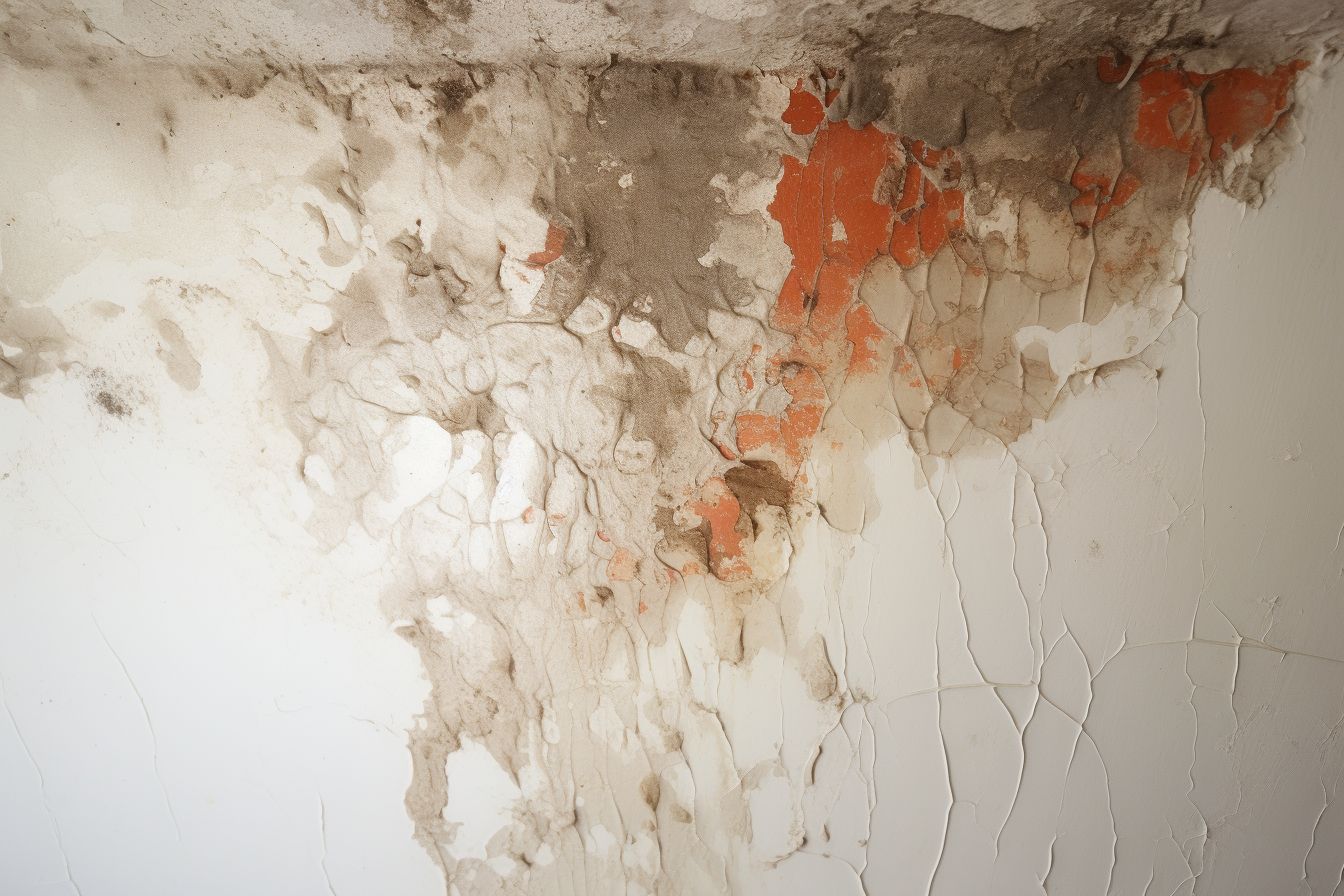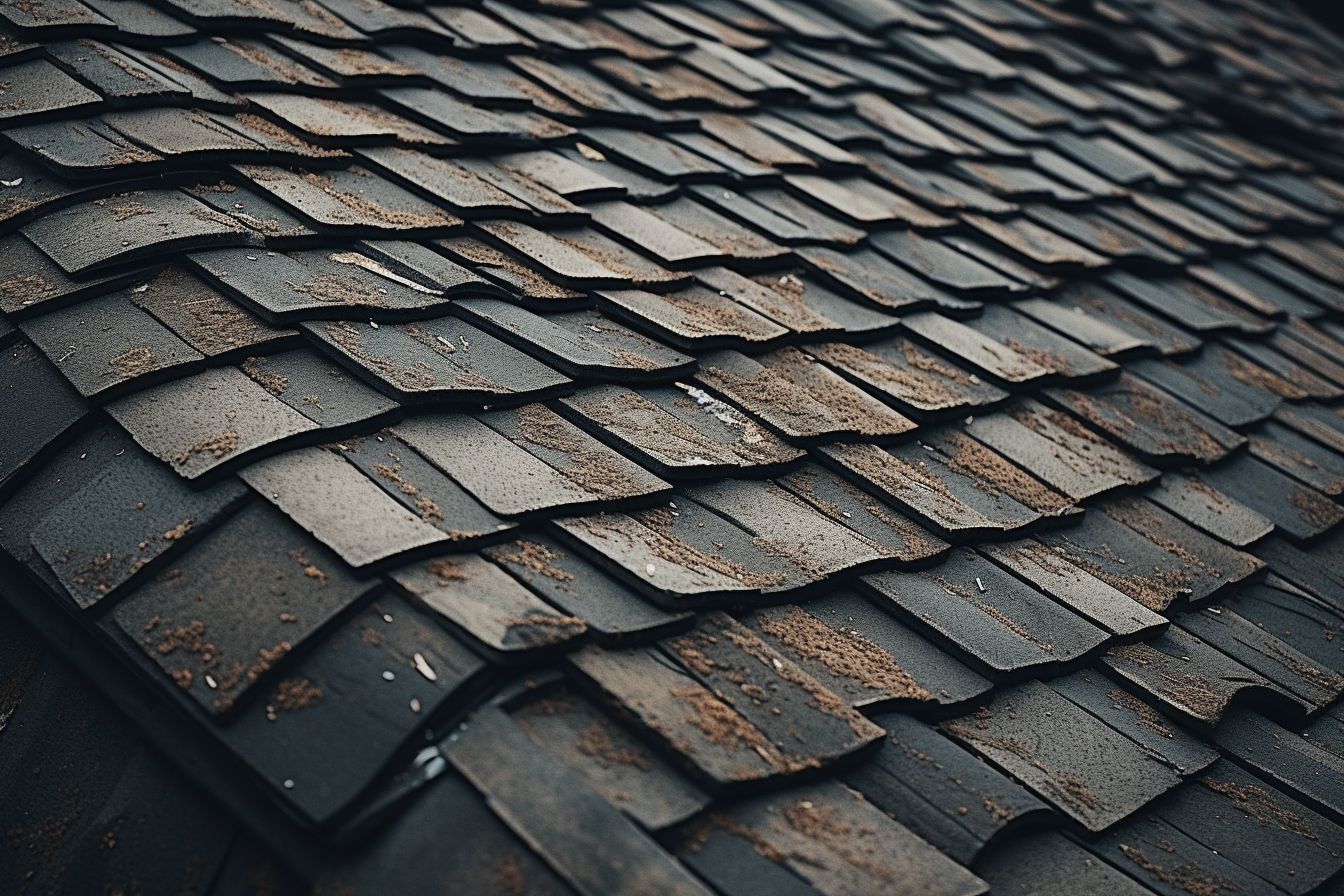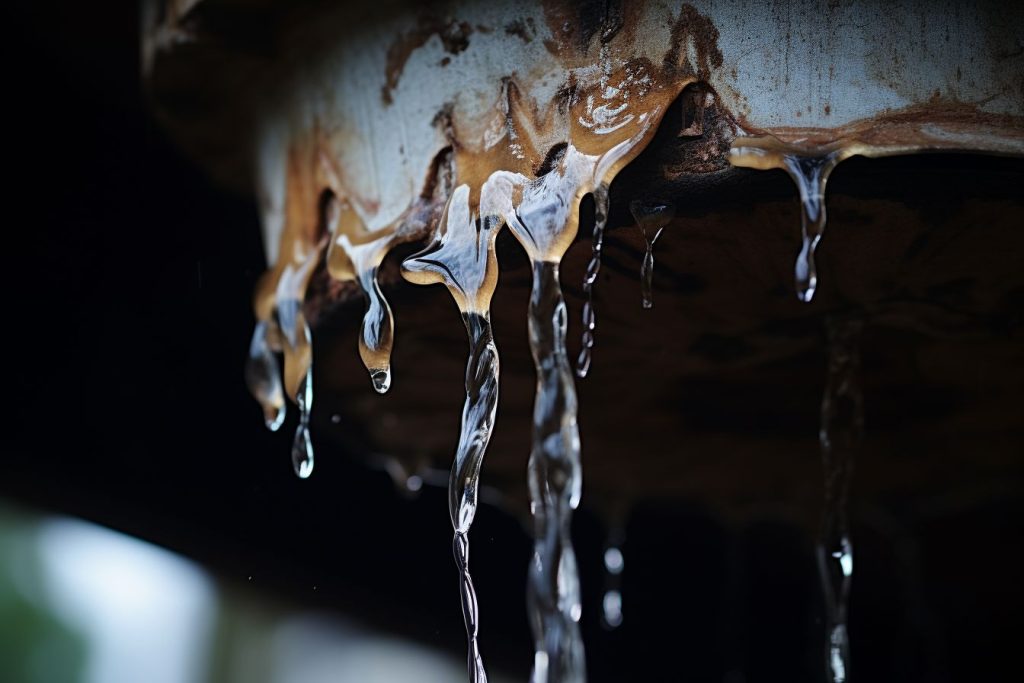Is your wall marred with unsightly water stains? These blemishes could indicate a leaky roof, an issue many homeowners face. This blog post is your ultimate guide to identifying the signs of a leaking roof and rectifying it before extensive damage occurs.
Let’s take this enlightening journey together so you can protect your home from further harm.
Key Takeaways
- Spots on the interior ceilings can indicate a leaky roof, so it’s important to take these signs seriously and address them promptly.
- Buckling or curling roof shingles are common signs of inadequate ventilation and can contribute to a leaky roof.
- Visible growths on exterior walls often signal roof damage and should be addressed to prevent further issues.
- Wet or rusty pipes are another sign of a leaky roof and should be inspected by a professional plumber.
Signs of a Leaky Roof
Spots on the interior ceilings could indicate a leaky roof.
Spots on the Interior Ceilings

Yellow, brown or faint spots on your ceiling can signal a leaky roof. The water leaks through the roof and stains the inner parts of your home, causing visible discolouration. This is common around bath fans, where water often seeps from the vent cap on the rooftop into your house’s interior.
Water damage is also signified by brown spots appearing on both ceilings and walls. In worse cases, you might notice bulges in these areas as well from trapped moisture swelling up underneath paint or wallpaper.
Taking these signs seriously is crucial since they indicate a potentially serious issue with your roofing system that needs immediate attention before it worsens further over time due to continued exposure to rainwater and condensation accumulation.
Buckling or Curling Roof Shingles
 Curling or buckling roof shingles are prevalent roofing problems that primarily indicate inadequate ventilation in your home. When there’s not enough airflow, moisture tends to get trapped under the shingle, causing it to buckle or curl.
Curling or buckling roof shingles are prevalent roofing problems that primarily indicate inadequate ventilation in your home. When there’s not enough airflow, moisture tends to get trapped under the shingle, causing it to buckle or curl.
Both these issues contribute significantly to a leaky roof and need immediate attention.
Poor quality materials are also responsible for curled shingles, so always ensure quality during installation. It’s worth noting that poorly installed, curled shingles can lead to cracks, which eventually cause nasty leaks.
Always check your roof regularly for signs of curling or buckling, as this could help prevent further roofing damage.
Exterior Wall Growths
Visible growths on exterior walls often signal a deeper issue – roof damage. Moisture seeping in from a leaky roof can create prime conditions for mold and other fungal infestations.
These unsightly patches, usually green or black, indicate persistent dampness from water intrusion. Over time, this unseen moisture erodes the structure of your home, causing more extensive damage to both health and property.
Notably, it’s possible to trace the source of the leak by measuring the distance from the mouldy area to a reference point like a door. Prevention starts with early detection; spotting these exterior wall growths is the first step towards resolving potential roofing issues.
Wet or Rusty Pipes
Wet or rusty pipes are common signs of a leaky roof. When water seeps through the roof, it can cause the pipes to become damp and corroded over time. The most common cause of a roof leak is when the boot around a pipe fails, allowing moisture to enter.
Additionally, gutter leaks often start at rusty spots or seams that have opened up due to expansion and contraction. It’s important to address these issues promptly, as dripping pipes and leaky roofs can contribute to the development of mould.
If you spot wet or rusty pipes in your home, it may be a good idea to schedule a roof inspection to determine the source of the leakage and take appropriate action.
Drips
Water dripping from the roof is a clear indication of a leaky roof. These drips can lead to brown spots on your interior ceilings, a telltale sign of roof damage. Dark water stains may also appear on walls with slow leaks.
Additionally, puddles caused by these drips can form on the floor or outside surfaces, creating slippery patches that pose a safety hazard. It’s important to address any signs of dripping immediately to prevent further water seepage and potential structural issues.
How to Spot a Leaky Roof
To spot a leaky roof, look out for these signs:
- Water spots on the ceiling or walls
- Missing or damaged shingles
- Cracked or damaged shingles
- Missing or damaged roof flashing
- Musty odours in certain rooms and wet spots on exterior walls
- Buckling or curling roof shingles
- Exterior wall growths
- Wet or rusty pipes
Actions to Take if You Spot a Leak
Take immediate action by calling a professional and scheduling a roof inspection to assess the extent of the damage. Repair or replace any damaged shingles or flashing, and address plumbing or pipe issues that may be contributing to the leak.
Call a Professional Immediately
Calling a professional roofer immediately is essential when you spot a leak in your roof. An experienced roofing contractor will have the knowledge and expertise to assess the extent of the damage and provide effective repair solutions.
By reaching out to a professional right away, you can prevent further water damage from occurring and avoid costly repairs down the line. Don’t wait – take action by calling a professional roofer as soon as you notice any signs of a leaky roof.
Schedule a Roof Inspection
Scheduling a roof inspection is crucial to maintaining the health and longevity of your roof. By having a professional roofing contractor conduct an annual inspection, you can identify potential issues before they become major problems.
They will thoroughly examine your roof for signs of damage, such as loose or missing shingles, weakened flashing, or areas susceptible to leaks. This proactive approach allows you to address any necessary repairs promptly and prevent costly water damage to your home.
Don’t wait until it’s too late – schedule a roof inspection today to ensure the continued protection of your home.
Repair or Replace Damaged Shingles or Flashing
Inspecting your roof for damaged shingles or flashing is crucial when dealing with a leaky roof. Damaged shingles can allow water to seep into the underlying layers, causing further damage and potential leaks.
If you notice any curling, buckling, or missing shingles, it’s important to address them promptly. Remove any old or damaged shingles and replace them with new ones. Additionally, inspect the flashing around chimneys, vents, and skylights, as they can also be sources of leaks.
Replace any damaged or rusting flashing with new ones to ensure proper sealing and protection against water intrusion.
Address Plumbing or Pipe Issues
Old pipes in your home may have outlived their usefulness and can cause leaks. To address plumbing or pipe issues, it is important to regularly check for any signs of water leaks, such as water stains or visible water dripping from the ceiling.
Detecting and locating these leaks early on can help prevent further damage and costly repairs. If you notice any puddles forming or rusty pipes, it’s best to call a professional plumber who can assess the situation and provide necessary repairs or replacements.
Taking prompt action can help protect your home from potential water damage and ensure the integrity of your plumbing system.
Conclusion
In conclusion, knowing how to spot a leaky roof is crucial for preventing extensive damage to your home. You can protect your property from further harm by paying attention to signs such as water stains on walls and ceilings, inspecting the attic and roof, and promptly addressing any leaks or damaged shingles.
Don’t hesitate to seek professional help if needed – taking action now can save you time and money in the long run.
FAQs
1. How can I spot a leaky roof?
You can spot a leaky roof by looking for signs such as water stains on the ceiling or walls, mould or mildew growth, dripping sounds, or visible damage to the roofing materials.
2. What should I do if I suspect a leak in my roof?
If you suspect a leak in your roof, it’s important to act quickly. First, place buckets or containers under the leaks to catch any water. Then, contact a professional roofer to inspect and repair the issue.
3. Can I fix a leaky roof myself?
Fixing a leaky roof yourself is not recommended as it requires specialized knowledge and safety precautions. It’s best to hire an experienced roofer who can accurately assess and repair the problem.
4. How long does it take to fix a leaking roof?
The time it takes to fix a leaking roof depends on various factors, such as the extent of the damage and accessibility of the area. Minor repairs may only take a few hours, while more extensive repairs could take several days.
5. What are common causes of roof leaks?
Common causes of roof leaks include damaged shingles or tiles, improper installation of flashing around chimneys or vents, clogged gutters causing overflow onto the roof, and age-related deterioration of roofing materials over time.

